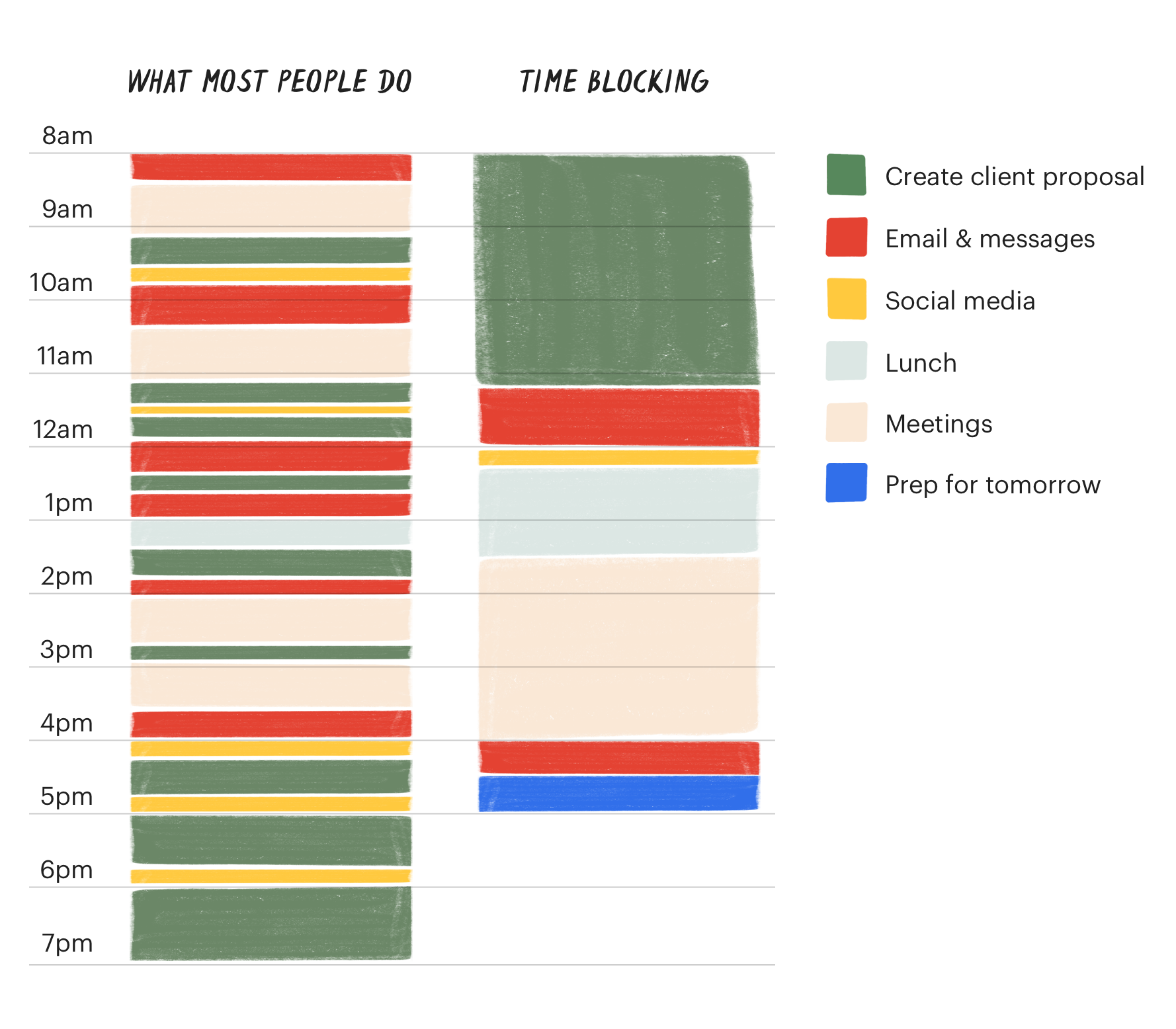The Pomodoro system is a time management system that divides time into working sessions and rest sessions. It was developed by Francesco Cirillo in the late 1980s. This method has been proven and advocated by many to combat procrastination, work for long periods of time and also maintain consistency. The name is Spanish for ‘Tomato’, which refers to the kitchen timers which used to countdown to 0, often shaped like tomatoes.
Why does it work?
Setting a timer for something creates a sense of urgency, this is similar to a Creative Constraint, but on a much lower scale. A timer creates Time Pressure but only for the task at hand. Time pressure refers to the sense of risk created by a limitation on the time available, it is a result of the application of a Creative Constraint, that is sort of like a box within which you, as a creator, will function. These constraints help you make the most out of your creative abilities.
When does it stop working?
Although the Pomodoro system has some clear benefits, it falls apart in certain contexts, and after sometime – as your focus and other skills develop – it may even become redundant. Here are some times when the Pomodoro Timer is no good.
If the breaks result in Context Switching and Attention Residue
Context Switching refers to rapidly switching between different and contrasting tasks that engage different mental abilities. As per research, when we switch from one task to another without it coming to an end, or without ‘letting go’ of it mentally, a portion of our attention remains with the earlier one, this is known as attention residue, it is based on the presumption that attention is a finite resource, and thus high levels of attention residue results in attention being wasted lost. The Pomodoro system requires you to let go of the task at hand and switch to a rest state, which may look like taking a walk, grabbing something to eat or drink, etc. even though these tasks aren’t attention utilizing, they still qualify as context switching, this can come in the way of focusing later, bringing me to my next point.
Pomodoro becomes a hurdle if you can focus
If you’ve ever been to a gym before, or watched videos on building muscle, then you’ll know that muscles grow by being stressed and worn out, this is called progressive overload, a common strategy to do this is to repeat a particular exercise until you can’t do it anymore, i.e. ‘Until Failure’. This method would not work if you just did the same number of repetitions everyday, even if you were capable of doing more, in fact it may even be detrimental. Similarly, if you can focus and can go on for longer without a break, then the Pomodoro system becomes a restriction, rather than an aide. If you are really engrossed in the material you’re reading, and suddenly your timer goes off, you may lose that engrossment, you may not be able to reach that point as easily again. To this you may say, “Then I’ll just skip my break, no problem. But that doesn’t work, because:
The Pomodoro must be treated as a rule for it to be effective
Remember when I talked about Time Pressure, and the sense of urgency, well both those things vanish as soon as you make skipping rest or work sessions an option. In order to utilize the benefits of the Pomodoro system properly, the system needs to be used as a rule, and not a guide. This is one of the major reasons why people don’t prefer the Pomodoro method. The malleability of a productivity system is something that is extremely important and a tailor made system will always be better as compared to a store brought one. That being said, you can change the duration of your work and rest sessions to better suit your personal goals, workflows and attention spans, because if you don’t follow the Pomodoro system as a rule, you won’t be getting the benefits it tries to bring either.
If you’re involved in collaborative workspace
Asking your entire team to take break every time your timer goes off can lead to meetings being unnecessary prolonged and will no doubt piss your teammates off. It’s important that you take the time of others into consideration as well. You cannot and should not make your team follow the cool tricks you learn on this blog because they are sleeple that have not found the treasure trove of knowledge that The Puranik Blog is.
Just Kidding
You shouldn’t be forcing strategies on anyone because they have the right to pick and choose what works for them.
When to stick to it?
That being said, there are certain situations where the Pomodoro System can help immensely, some of these are as follows:
Pomodoro for Procrastination
The Pomodoro timer is the best way to deal with procrastination. It helps you convince yourself to start working and also helps build momentum to eventually complete the larger project at hand. Set a Pomodoro timer and convince yourself that you only have to work for 25 minutes, that isn’t too long, and it isn’t too short either, it’s just the sweet spot. But once you get into the flow of working, you can probably convince yourself to either keep working, or do another 25 minutes after a 5 minute break. The Pomodoro system can help cure any case of procrastination, as long as you convince yourself, that it’s just 25 minutes.
Pomodoro prevents chance of Burnout
The pomodoro timer, forces you to take frequent breaks – thus lowering the chance of burnout by forcing you to refresh every few minutes. If you are going through a stressful period of time during which you can’t take a long break, but you need some sort of refreshment, then using the Pomodoro will work wonders for you.
For boring administrative tasks
Tasks like organizing files, forwarding e-mails to concerned parties and updating databases are boring and time-consuming, and often procrastinated. It is important to realize that these tasks – although unrewarding in the short run, make our lives easier in the long run – they make our systems work and may reduce the activation energy required to start related work in the future.
What to do instead?
So if I’m telling you to stop using the Pomodoro timer, it stands to reason that there must be something that is objectively better than the Pomodoro method that fixes the problems caused by the Pomodoro method, here are some of the methods that I have tried out and my experiences with them.
Cal Newport’s Time Blocking Technique
- From Deep Work: Rules for Focused Success in a Distracted World
- Material Below from: https://todoist.com/productivity-methods*/time-blocking
Cal Newport is a Computer Science Professor and Researcher who writes about making a more productive life in the age of technology. One of his methods for doing so is scheduling his day into blocks, that he can plan down to the minute. This is how that system works:

Time blocking is a time management method that asks you to divide your day into blocks of time. Each block is dedicated to accomplishing a specific task, or group of tasks, and only those specific tasks. Instead of keeping an open-ended to-do list of things you’ll get to as you’re able, you’ll start each day with a concrete schedule that lays out what you’ll work on and when. Time blocking asks you to set aside certain chunks of time to focus on a given task or activity. For example, “I will work on a first draft of my blog post from 9am to 11 am tomorrow.
“A 40 hour time-blocked work week, I estimate, produces the same amount of output as a 60+ hour work week pursued without structure.”
Cal Newport
When you schedule a chunk of time to work on a single project, problem, or task, you bring all of your mental resources to bear on one thing rather than spreading your attention thin across several tasks. It also helps you knock out “shallow work” more efficiently. Shallow work is the busy work that’s urgent but not important to achieving your long-term goals — think paperwork or responding to (most) emails. When you time box shallow work, you’re setting clear limits on how much time you’ll dedicate to it. Plus, grouping similar tasks together reduces the cost of context switching. By batching all of your shallow tasks together in a dedicated time block or two, you’ll be able to power through them more efficiently and protect the rest of your workday for higher-impact work.
1-2-3-4 To-Do List
This method focuses on treating time management as an Attention Management System. Instead of managing and planning your day down to the minute, this system focuses on doing work according to your attention reserves.

While I am a bit skeptical about how this method would pan out in the workplace, it works great for freelancers, students and even employees that are working from home. It allows you to get all types of work down, gives you sufficient time for the effects of context switching to dissipate and more. However the caveat is that this is in no way a long time replacement to traditional time management, rather it’s a method you can follow when you have a lot of varying tasks, or tasks dealing with different issues.
Setup: Construct a Daily Log with four signifier columns.
- The first column is used to mark quick or easy tasks (group 1).
- The second column is used to mark cleaning or tidying tasks (group 2).
- The third column is used to mark lengthy or difficult tasks (group 3).
- The fourth column is used to mark fun or relaxing tasks (group 4). For all tasks you rapid log, put a mark into one and only one of these four columns.
The process is to pick one task from each group for a total of four tasks. Do these four tasks in order (Do a group 1 task, then do a group 2 task, then do a group 3 task, then do a group 4 task). When you are working on this “chain” of tasks, try not to stop until you have finished all four. You need to do the four tasks in order because it’s psychological. First, you do a quick or easy task. These are the best for getting yourself going when you have very little motivation. After finishing that, you have built a little bit of momentum. Next, you do a cleaning or tidying task. These are a little longer but don’t require much mental energy, and you feel a sense of satisfaction when your living or working environment is clean (well, I do!). So when that’s done, you have a lot of momentum built up — time to do a big task. Now, you tackle a lengthy or difficult task since you’re at peak motivation. Once that’s done, you feel great but physically or mentally exhausted. Finally, it is time for a fun or relaxing task as a reward before (optionally) starting a new chain.
The Pomodoro timer is great and helpful, but it is not suited for work that is urgent, collaborative or something that requires long, continuous focus. To be more productive, we need to be willing to give up strategies and tactics when they don’t work, change them according to newer lessons and also be more mindful about what we choose to continue with.
I hope this post brought you value and helped you in some way, share your take-aways and experiments with this idea in the comments below. If you think this post deserves more attention then please consider sharing it with your friends and subscribing to this blog. Next post in two weeks. Have a great day!

